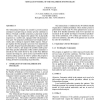Free Online Productivity Tools
i2Speak
i2Symbol
i2OCR
iTex2Img
iWeb2Print
iWeb2Shot
i2Type
iPdf2Split
iPdf2Merge
i2Bopomofo
i2Arabic
i2Style
i2Image
i2PDF
iLatex2Rtf
Sci2ools
WSC
2004
2004
Simulation Model of the Telemedicine Program
The Telemedicine Program was created to provide medical assistance to people living in extreme poverty conditions in Mexico. Through a satellite connection, a physician located in Mexico City can diagnose the patient who is physically inspected on a mobile unit, equipped with telecommunications gear. The program's performance has brought positive results, and is starting to expand to farther regions. This paper explains how the program's processes were simulated on a specially designed logical-mathematical computer model in order to observe, and analyze the possible results generated when specific information of the model's parameters is introduced. The results shown by the model when different scenarios are being run, can be used as a powerful tool in the decision making process in order to optimize the program's performance by maximizing its utilization and efficiency, looking forward to incrementing its productivity. 1 OPERATION OF THE TELEMEDICINE PROGRAM The p...
| Added | 31 Oct 2010 |
| Updated | 31 Oct 2010 |
| Type | Conference |
| Year | 2004 |
| Where | WSC |
| Authors | Juan Mauricio Lach, Ricardo Manuel Vázquez |
Comments (0)

